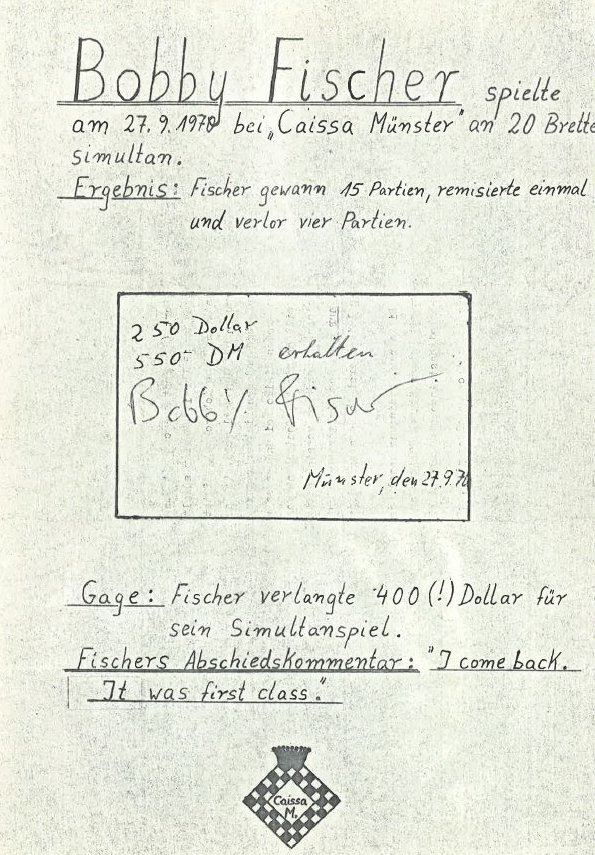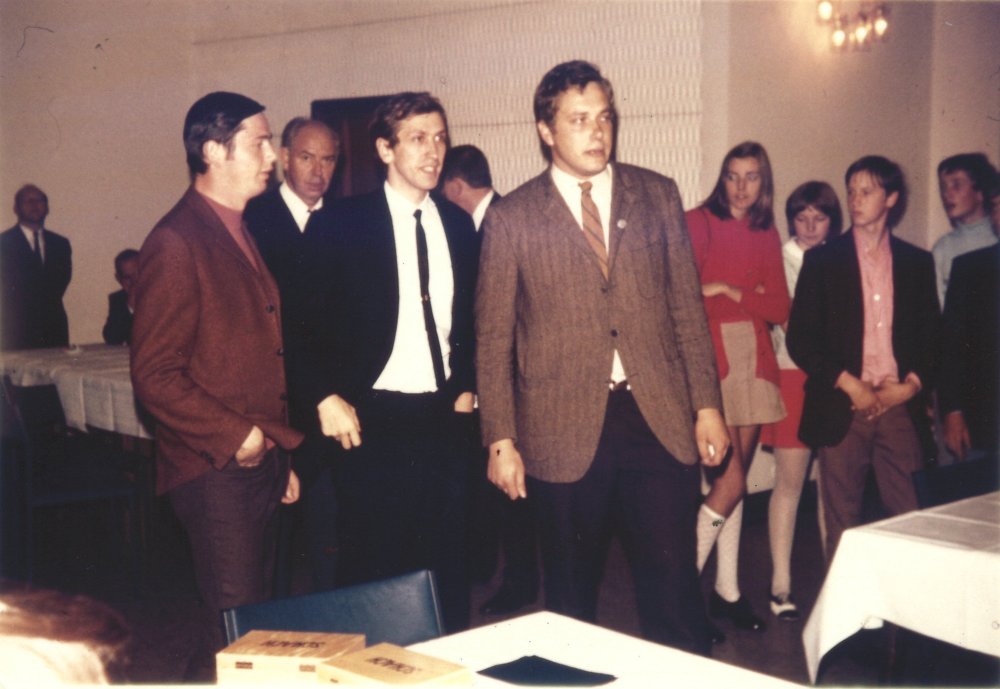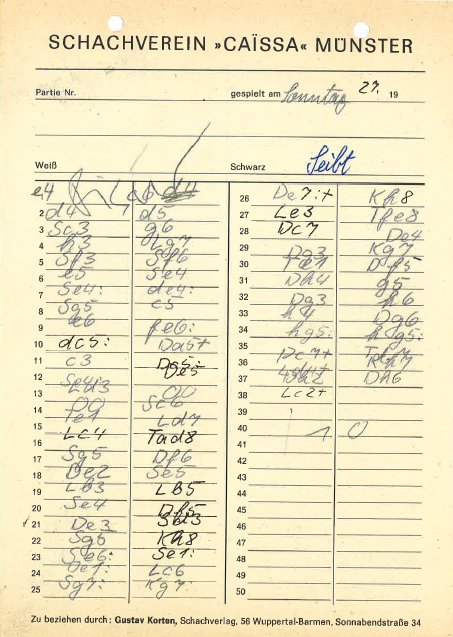.jpeg)

.jpeg)
Vlastimil Hort und Norbert Rauch contributed to this article
The following story continues Vlastimil Hort's memories of the Chess Olympiad in Siegen 1970, in which he played against Fischer. Hort's game against Fischer was adjourned and after a draw was agreed Hort invited Fischer to give a simul. A friend of Hort, Norbert Rauch, President of the Chess Club Caissa Münster, had asked Hort for this favour.
At that time Fischer already had a reputation as "enfant terrible". The Chess Olympiad in Siegen took place from September 5th to September 27th, and Fischer played on board one for the US team. It was the first and only time that Fischer and Samuel Reshevsky, the two top players in the US — who did not particularly like each other — played both for the US at a Chess Olympiad.
 Fischer's signature, left behind in Münster on a white sheet of paper and a number of score sheets.
Fischer's signature, left behind in Münster on a white sheet of paper and a number of score sheets.
Siegen 1970 was Fischer's last chess Olympiad. The US Chess Federation later tried to persuade him to play for the US in Olympiads but always failed because of Fischer's financial demands. In Siegen 1970, Fischer lost a famous game against Spassky and finished with a final score of 10.0/13 (77%), the second-best result on board — behind Spassky who finished with 9½/12 (79%).
Today, the team with the most team points wins gold at the Olympiad but in Siegen board points counted and the Soviet Union won with 27½, one point ahead of Hungary and 1½ points ahead of Yugoslavia. The USA finished on a disappointing fourth place. With Fischer on board one they came to Siegen to win gold but losses against East Germany in the preliminaries and against the Soviet Union in the finals put an end to these hopes.
Robert Fischer accepted Hort's invitation to play a simul in Münster, a German city in North Rhine-Westphalia that today has about 320,000 inhabitants and according to Wikipedia "is considered to be the cultural centre of the Westphalia region". Allegedly, Fischer did not like simuls because he was said to believe they would damage his play. However, in the course of his career he played a number of simuls and for Caissa Münster he also made an "exception".
Fischer did not only agree to play, he even agreed to a lower fee. He usually asked a fee of USD $400 for a simul. Today, this seems to be a ridiculously low sum but in 1970, $400 was worth much more than today and grandmasters could not ask for much. Moreover, the Soviet grandmasters who were very keen on foreign currency pressured prices. In fact, compared to the demands of his colleagues Fischer's standard fee of 400 dollars on which he usually insisted "out of principle" was rather high. But for the simul at Caissa Münster, Fischer was content with a fee of $250 dollars.

The receipt signed by Fischer
Chess historians knew that Fischer played such a simul in Münster but did not know the details. In John Donaldson's book "Bobby Fischer in Action: Simultaneous Exhibitions and Blitz Games" the author speculates about the time of the simul and comes close to the truth when he estimates that it took place between September 26th and September 28th. In fact, the event took place on September 27th, 1970, a Sunday. During his research, Donaldson found only the notation of Fischer's game against Ferdinand Middendorf which was published a year later, on March 19, 1971, in the Stuttgarter Zeitung. But Donaldson also found an article by Günter Langhanke which appeared in the online edition of the newspaper Westfälische Nachrichten (unfortunately no longer available).
Langhanke had picked up Fischer at his hotel in Solingen at 3 pm and then the two took the train to Münster. He remembers that the staff in the hotel was hesitant to disturb Fischer at that time. Apparently, the future World Champion had managed to gain a certain reputation in the hotel.

Bobby Fischer arrives to play a simul at Caissa Münster

Fischer entered the arena
Fischer allowed a maximum number of 20 opponents. However, he did not set a limit to the strength of his opponents and expected rather strong players. And he was right. It cost 25 Deutschmarks to play against Fischer and thus the fees the players had to pay approximately covered the costs of the simul.
The simul took place in the ballroom of a restaurant at Münster main station and attracted quite a few journalists and a lot a spectators — about a hundred people tried to get a glimpse of the games and the American. Fischer was playing alternately with White and with Black and at 6 pm he started to get down to work.

The players are ready | All photos: Norbert Rauch

Intense as ever

The simul in progress

Bobby Fischer at work

Smoking was still allowed! Fischer's opponent is Ullrich Nehmert.

Ferdinand Middendorf (right) has to defend against a knight sacrifice on e6
Fischer finished the 20 games in three hours, which was rather long for him because Fischer was considered to be one of the fastest simul players around.
However, Fischer's result was not particularly good; he lost against Budt (Bünde), Langhanke (Caissa Münster), Lentze (Münster 32), Dr. Poeschel (Münster 32), and drew against Nehmert. The other 15 games were won by Fischer.

He signed a couple of score sheets, though not always accurately.

From Münster Fischer travelled to Solingen where he gave another simul on September 29th, 1970, again against 20 opponents. The organiser of the event was Egon Evertz, entrepreneur, musician, race-driver and sponsor of the chess club SG Solingen. In Solingen, Fischer again faced stubborn resistance and lost no less than five games: against Dr. Manfred Christoph, Ulrich Dresen, Karl-Heinz-Bachmann, Albert Nowak, and Lothar Drehen. Dr. Christian Clemens, H. Bergfeld, and Helmut Merckel came to a draw. In Solingen Fischer was accompanied by Grandmaster Miguel Quinteros and received a fee of USD $400.
In Solingen, one player later complained about Fischer's impolite behaviour but the people in Münster had good memories of him. Fischer had nothing to complain about at Caissa Münster and his behaviour was polite and exemplary. The American was grateful for the invitation and promised: "I come back. It was first class."

Fischer signs a score sheet and working hard
Norbert Rauch, initiator and organiser of the simul in Münster, took pictures during the event and collected the score sheets. After the simul he put the documents, including a number of autographs by Fischer and a couple of newspaper articles, into a file which he kept until today, for almost 50 years.

Recently, Vlastimil Hort and Norbert Rauch met again at a tournament for seniors and indulged in memories: "Oh yes, do you remember the simul with Bobby Fischer?" And Norbert Rauch remembered that he still had that file with the documents of the simul. Which thanks to Hort and Rauch are now available for all chess fans!
Translation from German: Johannes Fischer
| Advertising |